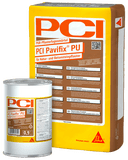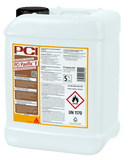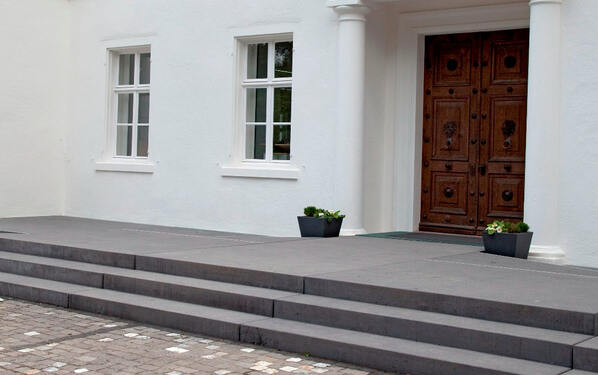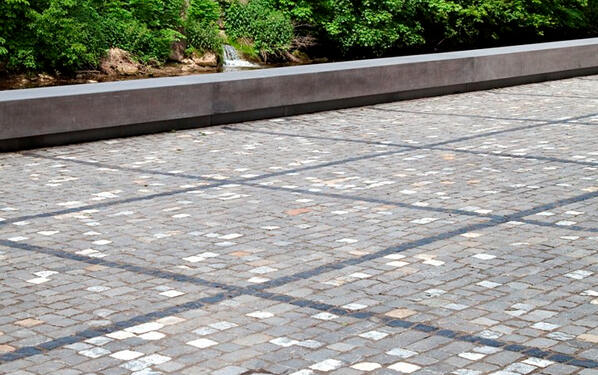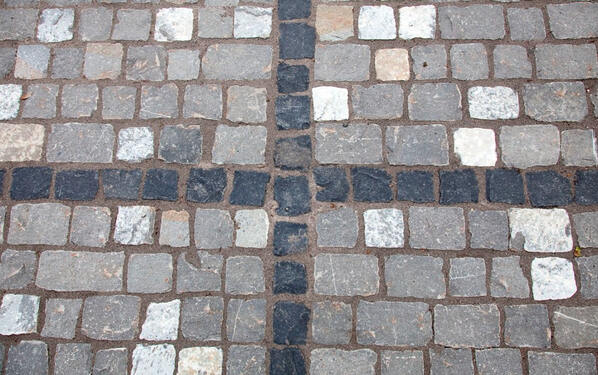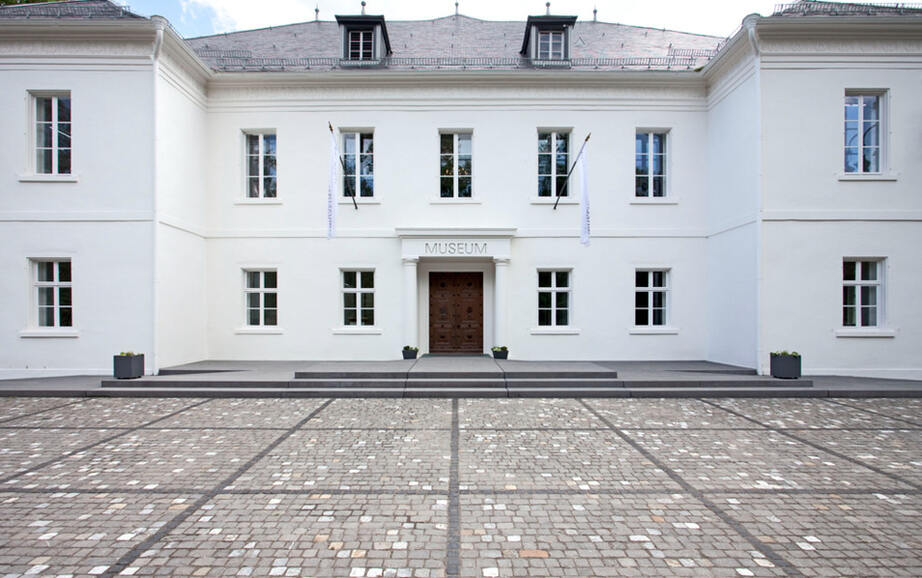
Museum Biedermann
Redesigning the forecourt of a museum with natural stone paving
Products used
Museum Biedermann
Redesigning the forecourt of a museum with natural stone paving
The completely renovated Museum Biedermann in Donaueschingen, Germany, with its redesigned forecourt has regained a harmonic aura. Now the visitors' art experience begins even before they enter the museum. Special products by PCI Augsburg GmbH were used in the paving work in front of the building.
Today's Museum Biedermann has a long and widely varied history. It was inaugurated in 1841 and served as a prestigious seat of the Donaueschingen Museum Society. Just 4 years later a fire destroyed the 2-storey building. It was ready for use again in 1847. During the following 90 years the building was used as accommodation for reserve soldiers and as a municipal spa hotel – up until 1937 when a cinema moved in called the "Museumslichtspiele" [Museum Light Show]. After it closed the Biedermann entrepreneurial family expressed a desire in 2006 to revive the cultural significance of the building by turning it into a museum for contemporary art. The classicist structure is located in a wide-ranging park. Renovation work began in 2008. About a year later the Museum Biedermann was opened. During the extensive renovations the forecourt was given a new look as well.
When one compares the previous condition of this space in front of the museum with how it looks now, the comparison makes it obvious how well the facade harmonises with the redesigned square. This makes the overall external optical effect one of an extremely harmonious ensemble. In order to achieve this effect, the Swiss architects in charge, Tanja Raufer and Lukas Gäbele, hired professionals to carry it out: 2 specialist companies, the "Atelier für Grün- und Landschaftsbau" [Greenways and Landscaping Studio] (Donaueschingen) and the Kopp & Grimm GmbH.
The paving for the 900 sqm was selected with great care. The final decision was to use a composition of Guber quartz sandstone (8/11), bowl stones, white cobblestones and rows of basalt paving (9/9/9) from Switzerland. The joint material was to be of material just as valuable as the natural stone paving. Those persons responsible for the project chose select products from the PCI Pavifix program, because it is a comprehensive system, facilitates satisfactory hardness while at the same time enabling water permeability. And it is also no problem to work with. Furthermore, the decisive factor was the neutral interaction between the joint grout and the natural stone. After application, the grout also had to fully retain the original colour. The joints should also be water permeable, but sealed, so that no weeds could grow between the natural stones.
The work began with a slight delay: "To begin with the old surface had to be removed. After the preparations were concluded, the area to be paved was 45 cm too low", recalls Jörn Grimm, Managing Director of the Kopp & Grimm GmbH carrying out the work. In order to balance out the difference in level, the team first spread out mineral filler and crushed stone on the very firm subsurface.
The entire paving was compacted via vibration before pre-prepping and grouting, because the square has to withstand vehicle traffic. "In order to ensure a 40 mm joint depth for the water-permeable PCI Pavifix PU paving joint grout, we used a joint cleaning device to thoroughly clean out all joints", reports Jörn Grimm. Then the paving stones were pre-impregnated with PCI Pavifix V in order to conserve the natural original colouring. A protective film forms over the stone surface during this process. An additional advantage of using PCI Pavifix V is: any impurities after the grout has hardened are easier to remove later due to the application of PCI Pavifix V. Another advantage of PCI Pavifix PU is its good pourability ensuring you can work quickly. Anthracite was the colour which was most optimally suited to the natural stone selected. Along with the water permeable grout, a drainable substructure now ensures that any water which seeps through is sure to run off.
There were 4-6 Kopp & Grimm specialists occupied for a total of around 3 months redoing the forecourt. Alongside the actual paving work this also involved installing a light strip border, various illuminants, benches and an elevated entry slab. The finished results are well worth a look – in a very literal sense.
Today's Museum Biedermann has a long and widely varied history. It was inaugurated in 1841 and served as a prestigious seat of the Donaueschingen Museum Society. Just 4 years later a fire destroyed the 2-storey building. It was ready for use again in 1847. During the following 90 years the building was used as accommodation for reserve soldiers and as a municipal spa hotel – up until 1937 when a cinema moved in called the "Museumslichtspiele" [Museum Light Show]. After it closed the Biedermann entrepreneurial family expressed a desire in 2006 to revive the cultural significance of the building by turning it into a museum for contemporary art. The classicist structure is located in a wide-ranging park. Renovation work began in 2008. About a year later the Museum Biedermann was opened. During the extensive renovations the forecourt was given a new look as well.
When one compares the previous condition of this space in front of the museum with how it looks now, the comparison makes it obvious how well the facade harmonises with the redesigned square. This makes the overall external optical effect one of an extremely harmonious ensemble. In order to achieve this effect, the Swiss architects in charge, Tanja Raufer and Lukas Gäbele, hired professionals to carry it out: 2 specialist companies, the "Atelier für Grün- und Landschaftsbau" [Greenways and Landscaping Studio] (Donaueschingen) and the Kopp & Grimm GmbH.
The paving for the 900 sqm was selected with great care. The final decision was to use a composition of Guber quartz sandstone (8/11), bowl stones, white cobblestones and rows of basalt paving (9/9/9) from Switzerland. The joint material was to be of material just as valuable as the natural stone paving. Those persons responsible for the project chose select products from the PCI Pavifix program, because it is a comprehensive system, facilitates satisfactory hardness while at the same time enabling water permeability. And it is also no problem to work with. Furthermore, the decisive factor was the neutral interaction between the joint grout and the natural stone. After application, the grout also had to fully retain the original colour. The joints should also be water permeable, but sealed, so that no weeds could grow between the natural stones.
The work began with a slight delay: "To begin with the old surface had to be removed. After the preparations were concluded, the area to be paved was 45 cm too low", recalls Jörn Grimm, Managing Director of the Kopp & Grimm GmbH carrying out the work. In order to balance out the difference in level, the team first spread out mineral filler and crushed stone on the very firm subsurface.
The entire paving was compacted via vibration before pre-prepping and grouting, because the square has to withstand vehicle traffic. "In order to ensure a 40 mm joint depth for the water-permeable PCI Pavifix PU paving joint grout, we used a joint cleaning device to thoroughly clean out all joints", reports Jörn Grimm. Then the paving stones were pre-impregnated with PCI Pavifix V in order to conserve the natural original colouring. A protective film forms over the stone surface during this process. An additional advantage of using PCI Pavifix V is: any impurities after the grout has hardened are easier to remove later due to the application of PCI Pavifix V. Another advantage of PCI Pavifix PU is its good pourability ensuring you can work quickly. Anthracite was the colour which was most optimally suited to the natural stone selected. Along with the water permeable grout, a drainable substructure now ensures that any water which seeps through is sure to run off.
There were 4-6 Kopp & Grimm specialists occupied for a total of around 3 months redoing the forecourt. Alongside the actual paving work this also involved installing a light strip border, various illuminants, benches and an elevated entry slab. The finished results are well worth a look – in a very literal sense.
Today's Museum Biedermann has a long and widely varied history. It was inaugurated in 1841 and served as a prestigious seat of the Donaueschingen Museum Society. Just 4 years later a fire destroyed the 2-storey building. It was ready for use again in 1847. During the following 90 years the building was used as accommodation for reserve soldiers and as a municipal spa hotel – up until 1937 when a cinema moved in called the "Museumslichtspiele" [Museum Light Show]. After it closed the Biedermann entrepreneurial family expressed a desire in 2006 to revive the cultural significance of the building by turning it into a museum for contemporary art. The classicist structure is located in a wide-ranging park. Renovation work began in 2008. About a year later the Museum Biedermann was opened. During the extensive renovations the forecourt was given a new look as well.
When one compares the previous condition of this space in front of the museum with how it looks now, the comparison makes it obvious how well the facade harmonises with the redesigned square. This makes the overall external optical effect one of an extremely harmonious ensemble. In order to achieve this effect, the Swiss architects in charge, Tanja Raufer and Lukas Gäbele, hired professionals to carry it out: 2 specialist companies, the "Atelier für Grün- und Landschaftsbau" [Greenways and Landscaping Studio] (Donaueschingen) and the Kopp & Grimm GmbH.
The paving for the 900 sqm was selected with great care. The final decision was to use a composition of Guber quartz sandstone (8/11), bowl stones, white cobblestones and rows of basalt paving (9/9/9) from Switzerland. The joint material was to be of material just as valuable as the natural stone paving. Those persons responsible for the project chose select products from the PCI Pavifix program, because it is a comprehensive system, facilitates satisfactory hardness while at the same time enabling water permeability. And it is also no problem to work with. Furthermore, the decisive factor was the neutral interaction between the joint grout and the natural stone. After application, the grout also had to fully retain the original colour. The joints should also be water permeable, but sealed, so that no weeds could grow between the natural stones.
The work began with a slight delay: "To begin with the old surface had to be removed. After the preparations were concluded, the area to be paved was 45 cm too low", recalls Jörn Grimm, Managing Director of the Kopp & Grimm GmbH carrying out the work. In order to balance out the difference in level, the team first spread out mineral filler and crushed stone on the very firm subsurface.
The entire paving was compacted via vibration before pre-prepping and grouting, because the square has to withstand vehicle traffic. "In order to ensure a 40 mm joint depth for the water-permeable PCI Pavifix PU paving joint grout, we used a joint cleaning device to thoroughly clean out all joints", reports Jörn Grimm. Then the paving stones were pre-impregnated with PCI Pavifix V in order to conserve the natural original colouring. A protective film forms over the stone surface during this process. An additional advantage of using PCI Pavifix V is: any impurities after the grout has hardened are easier to remove later due to the application of PCI Pavifix V. Another advantage of PCI Pavifix PU is its good pourability ensuring you can work quickly. Anthracite was the colour which was most optimally suited to the natural stone selected. Along with the water permeable grout, a drainable substructure now ensures that any water which seeps through is sure to run off.
There were 4-6 Kopp & Grimm specialists occupied for a total of around 3 months redoing the forecourt. Alongside the actual paving work this also involved installing a light strip border, various illuminants, benches and an elevated entry slab. The finished results are well worth a look – in a very literal sense.
Today's Museum Biedermann has a long and widely varied history. It was inaugurated in 1841 and served as a prestigious seat of the Donaueschingen Museum Society. Just 4 years later a fire destroyed the 2-storey building. It was ready for use again in 1847. During the following 90 years the building was used as accommodation for reserve soldiers and as a municipal spa hotel – up until 1937 when a cinema moved in called the "Museumslichtspiele" [Museum Light Show]. After it closed the Biedermann entrepreneurial family expressed a desire in 2006 to revive the cultural significance of the building by turning it into a museum for contemporary art. The classicist structure is located in a wide-ranging park. Renovation work began in 2008. About a year later the Museum Biedermann was opened. During the extensive renovations the forecourt was given a new look as well.
When one compares the previous condition of this space in front of the museum with how it looks now, the comparison makes it obvious how well the facade harmonises with the redesigned square. This makes the overall external optical effect one of an extremely harmonious ensemble. In order to achieve this effect, the Swiss architects in charge, Tanja Raufer and Lukas Gäbele, hired professionals to carry it out: 2 specialist companies, the "Atelier für Grün- und Landschaftsbau" [Greenways and Landscaping Studio] (Donaueschingen) and the Kopp & Grimm GmbH.
The paving for the 900 sqm was selected with great care. The final decision was to use a composition of Guber quartz sandstone (8/11), bowl stones, white cobblestones and rows of basalt paving (9/9/9) from Switzerland. The joint material was to be of material just as valuable as the natural stone paving. Those persons responsible for the project chose select products from the PCI Pavifix program, because it is a comprehensive system, facilitates satisfactory hardness while at the same time enabling water permeability. And it is also no problem to work with. Furthermore, the decisive factor was the neutral interaction between the joint grout and the natural stone. After application, the grout also had to fully retain the original colour. The joints should also be water permeable, but sealed, so that no weeds could grow between the natural stones.
The work began with a slight delay: "To begin with the old surface had to be removed. After the preparations were concluded, the area to be paved was 45 cm too low", recalls Jörn Grimm, Managing Director of the Kopp & Grimm GmbH carrying out the work. In order to balance out the difference in level, the team first spread out mineral filler and crushed stone on the very firm subsurface.
The entire paving was compacted via vibration before pre-prepping and grouting, because the square has to withstand vehicle traffic. "In order to ensure a 40 mm joint depth for the water-permeable PCI Pavifix PU paving joint grout, we used a joint cleaning device to thoroughly clean out all joints", reports Jörn Grimm. Then the paving stones were pre-impregnated with PCI Pavifix V in order to conserve the natural original colouring. A protective film forms over the stone surface during this process. An additional advantage of using PCI Pavifix V is: any impurities after the grout has hardened are easier to remove later due to the application of PCI Pavifix V. Another advantage of PCI Pavifix PU is its good pourability ensuring you can work quickly. Anthracite was the colour which was most optimally suited to the natural stone selected. Along with the water permeable grout, a drainable substructure now ensures that any water which seeps through is sure to run off.
There were 4-6 Kopp & Grimm specialists occupied for a total of around 3 months redoing the forecourt. Alongside the actual paving work this also involved installing a light strip border, various illuminants, benches and an elevated entry slab. The finished results are well worth a look – in a very literal sense.
Date
24.09.2010
Task
Redesigning the forecourt of a museum with natural stone paving
City
Donaueschingen
Completion
2010
Size
900 m²
Products used
PCI Pavifix® PU, PCI Pavifix® V
Owner
Museum Biedermann
Company
garten & landschaftsbau Kopp & Grimm, Mönchweiler
Architect
Architekturbüro gäbele & raufer; Atelier für Grün- und Landschaftsplanung Donaueschingen
Your contact for inquiries:
PCI Augsburg GmbH
Piccardstraße 11, 86159 Augsburg
Telefon: 0821 5901-0
Telefax: 0821 5901-416
E-Mail: pci-info@pci-group.eu
www.pci-augsburg.de

